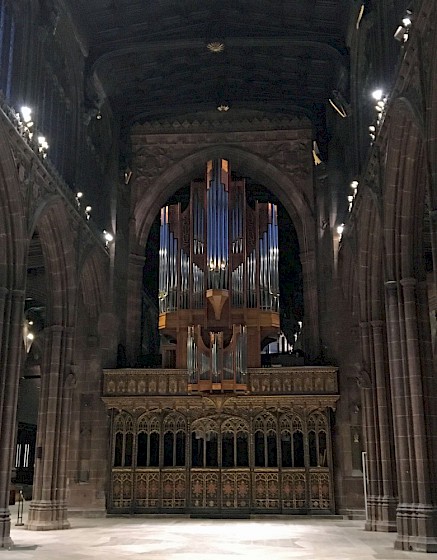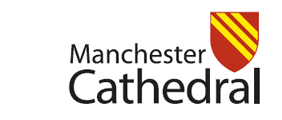The Cathedral Organs
The history of the early organs in Manchester Collegiate Church is clouded. Certainly, however, there was an organ here by 1635, as there was an organist appointed that year.
The genesis of the famous Choir organ in the church is clear from the Chapter register for 6th February 1682: "then met in chapter Mr Mosley, Mr West and Mr Ogden at which time it was voted that Mr Smith have for an organ for the use of the choir only £20 and that fifth part thereof shall be forthwith paid to Mr Smith the make of the organ and the remainder when finished and set up."
The organ was completed by 'Father' Bernard Smith in 1684. It stood on the screen until 1861, when it was removed to a side chapel and a large three manual organ was installed in the Jesus Chapel by Nicholson.
In 1871 a new organ was built by Hill & Son, the main part of which stood on the screen in the new case by Sir George Gilbert Scott. This organ was rebuilt by the same firm in 1910, with the majority of the organ divided each side of the choir stalls, and a second Great division on the screen. It was revoiced and altered by Harrison & Harrison in 1918.
In 1934 Harrison & Harrison carried out a further scheme of restoration and additions, with the provision of new electro-pneumatic action. The choir organ was enclosed and re-modelled, and the small Father Smith organ was connected to the main console whilst also remaining playable from its own keyboard.
In December 1940, the organ was partially destroyed in an air raid. The Swell, Solo and most of the Pedal organ was seriously damaged; the Great, Choir and screen departments were only slightly harmed; and the console alone remained intact. The Father Smith organ was destroyed. In 1943 a temporary two-manual organ was constructed by Harrison & Harrison.
The organ which remained until 2015 and which incorporated pipework of the 1934 organ, was installed between 1952 and 1957. The specification was drawn up by Norman Cocker, the then Cathedral Organist, in consultation with the organ builders, with certain modification suggested by his successor, Allan Wicks.
The organ was located within two westerly bays of the choir aisles. The Choir and Great organs were on the south side; the Swell and Solo on the north; the Pedal on both sides, with the open woods and ophicleides in the Jesus Chapel. The new console was placed in the chancel; the old console was retained and placed in the nave.
Restoration work was carried out in 1974 and 1979, when solid-state coupler and combination actions were provided. The nave console was removed, and the chancel console placed on the quire screen.

The new Stoller Organ, built by the Northampton firm of Kenneth Tickell and Company, has been designed to enhance worship in both the chancel and nave of the Cathedral, as well as being a distinguished concert and recital instrument. The musical and liturgical needs of a cathedral should govern the design and placement of an instrument and, for most of the working life of this Cathedral, an organ, or portions of an organ, have been included on the screen. The beautiful medieval screen has been reinforced to allow the new organ to sit above it with case fronts facing both east to the altar and quire, where daily services are sung, and west to the newly paved nave where Sunday morning services, many concerts and diocesan and national services take place.
The new Stoller Organ, of six divisions, comprises 79 stops over four manuals and pedal. The main screen case contains the Great, Swell and Pedal, arranged to speak equally east and west. A Choir organ speaks east into the chancel and a west facing Positif organ provides solo repertoire orientated stops. Both of these divisions play from the same manual, the Choir organ also being transferable to the Solo manual by means of a drawstop. On the south side of the chancel, a two-level Solo organ has been provided in a position least evident from the nave, allowing new eastward vistas to be revealed. The Jesus Chapel Pedal 32' stops has been retained, as have two of the high pressure solo reeds and the Contre Viole. The organ has tracker key action for Great, Swell, Positive and screen Pedal, and electric action for the Solo, Choir and 32' pedal chests. All coupling is electric.
The Stoller Organ may be played from either of two consoles; a mechanical action screen console positioned on the north side of the case, or the mobile electric-action console in the main body of the building.
The beautiful pipe shades have been designed by text artist Stephen Raw. The lettering on the pipe shades is taken from the words of the liturgy in Latin, the common language of Christian worship internationally. The cut-through lettering helps to release sound. There are over 4800 pipes inside the instrument, ranging from 6 inches to 32 feet high. The pipes facing into the quire were gilded by hand with wafer-thin 23.5 carat gold leaf, so that they will never tarnish.
The building works completed in the winter of 2016/17, the voicing and sounding of the instrument took place from January to April 2017.
The Dedication and Blessing of the new Stoller Organ, with a recital by world-renowned concert organist, Thomas Trotter was held on Thursday 14 September 2017.
- Download detailed key actions of the Stoller Organ.
- Download the report on the build of the Stoller Organ.
- Photographs taken during the building and installation of the new organ can be viewed on our Facebook page Opens in new window .


